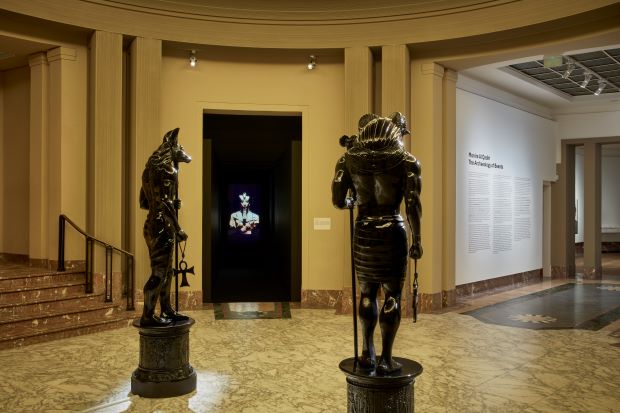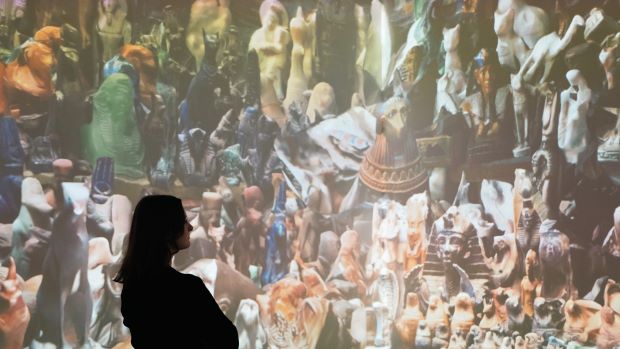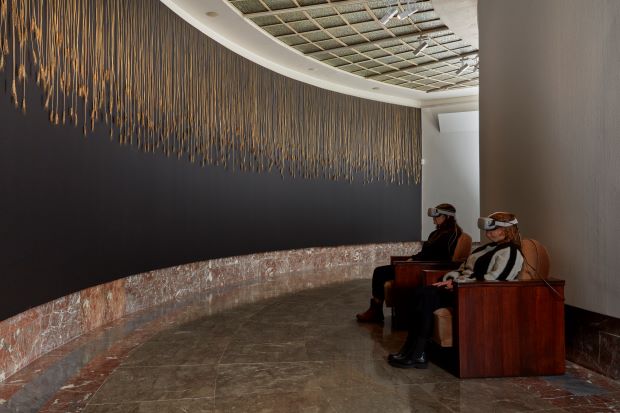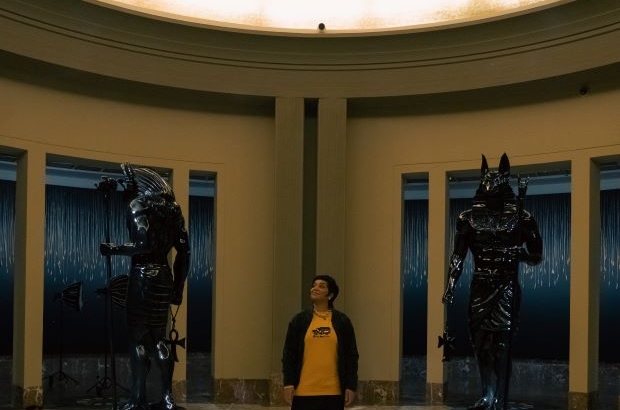- Daily & Weekly newsletters
- Buy & download The Bulletin
- Comment on our articles
Human vs animal: Artist Monira Al Qadiri taps into Ancient Egyptian culture to explore power relationship
Two towering figures herald Kuwaiti artist Monira Al Qadiri’s solo exhibition The Archaeology of Beasts: four powerful new installations occupying the space in and around Bozar’s rotunda.
The imposing black-glossed Egyptian animal deities – Anubis and Khnum – stand triumphantly in a hyper-masculine duel, rotating on pedestals for additional macho spectacle.
Entitled Automaton, the pair of ready-made statues originally destined for the home décor market were transformed by Al Qadiri to exaggerate their sexuality and accentuate the former fluid mutation between human, animal and divine.

“I painted them in black and put them on rotating platforms to highlight the spectacle of the ‘other’. We always see the other as less human than us, as animal,” she points out.
One of “the boys” is the god of the underworld, the other a god of fertility and of life, “so there’s a dichotomy between them,” explains the artist, who deliberately applied an automotive high-end sheen more suited for a car show to further accentuate their masculinity.
If the relationship between humans and nature in the context of the environment has long been central to her work, Ancient Egypt is a new obsession for Berlin-based Al Qadiri. Internationally-renowned for her large-scale works exploring the history of the Gulf region and its petrochemical activities, she was raised in Kuwait, but born in Senegal and has also lived in Japan and Beirut. “I’m a cultural Frankenstein,” she laughs.

A research trip to Luxor inspired her second installation Archaeology of Beasts, a video installation that runs on a 4-minute loop, accompanied by a sound track signed Raed Yassin. It’s an unsettling immersive experience for the viewer with a revolving cascade of Egyptian souvenirs and animal figures that perpetuate the theme of otherness.
In search for analogies to reinterpret the ancient culture, Al Qadiri visited a tourist shop. “To make you feel like you are an archaeologist, they put all the souvenirs on top of each other, and play with your emotions as you try and find something ‘rare’.”
When subsequently scanning the mounds of souvenirs, she imagined the objects as bodies piled on top of each other. “It’s an allegory about the different kinds of bodies we see on our screens. When they are deformed like this, there’s a form of frailty.” Al Qadiri describes the video as psychedelic, “the more you look at it, the more crazy you feel”.

Ancient gods are brought alive in the three-way video and sound installation Book of the Dead. Visitors enter a darkened tomb-like tunnel to witness a conversation between seven animated creatures reading the ancient funerary text with AI generated voices. The central figure is human, the rest of the cast animal deities.
The latter was a deliberate ploy by Al Qadiri. She adapted the text – originally written to accompany the dead when they crossed over to the afterlife – to include conversations between animals so as to question notions of hierarchy. “The humans are full of themselves, while the animals argue among themselves.” She was struck by how the texts sounded contemporary; an impression that is reinforced by the use of AI.

The final installation employs Virtual Reality to create an additional sensory and immersive moment. Arau: After Lament is a strikingly beautiful and minimalist work, accompanied by a piece of music written by the artist’s sister Fatima Al Qadiri.
It evokes a paradisical field of golden wheat that the ancient Egyptians believed awaited them in the afterlife. It was why the dead were often buried with farming tools in their coffins. While heaven represented a place of both labour and eternal rest, farming was a symbol of social status. In the VR experience, a sacred cow appears in the apparently idyllic sun-filled scene.
The gold-painted wheat flower heads that are suspended from elongated stems on a black wall each represent a departed soul. This reflection on life after death is a poignant reminder of how the ancient civilisation celebrated the cycle of life.
Al Qadiri is appreciative of the opportunity to create the in-situ installations. “Bozar allowed me to experiment with my obsessions as artists are usually expected to present the same body of work. Here I worked directly with the unconventional space in mind to create an unconventional show.”

Admiring the elegant lines and harmonious colours of the rotunda at the heart of the space, Al Gadiri reflected on the similarity between her own inspiration and that of the Art Deco building’s architect Victor Horta. He was a prominent freemason, an order that drew on Ancient Egyptian style elements.
For Bozar’s head of exhibitions Zoë Gray, Al Qadiri has created “a remarkable new body of work that uses the myths of Ancient Egypt as a filter through which to consider pressing questions about today.”
She believes there are numerous levels of play in the artworks. “You can walk away thinking the they are only about Ancient Egypt, but you can also think about the prayers and rituals around death, which is also very pertinent in our world today.”
The artist recalled the humbling experience of exploring a less-frequented and claustrophobic tomb in Luxor. “In the narrow space, the drawings looked like they were painted yesterday: scenes of daily life, people eating, drinking wine, dancing.” She felt she was transported back in time, as with VR. “From all this culture and civilisation, the only thing that remains in a way is the art. Sometimes people ask why are you making art, it doesn’t mean anything, but actually it’s the only thing that keeps the human trace alive.”
The exhibition is showing in parallel to Hans/Jean Arp & Sophie Taeuber-Arp. Friends, Lovers, Partners, a detailed display of the couple’s pioneering 20th century art, and Love is Louder, a tender portrayal of human relationships since the 1967 ‘Summer of Love’.
The Archaeology of Beasts
Until 9 March
Bozar
Rue Ravenstein 23
Brussels
Photos: Bozar exhibition Monira Al Qadiri ©Julie Pollet


















